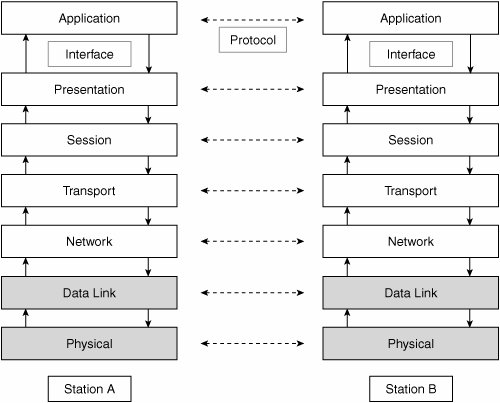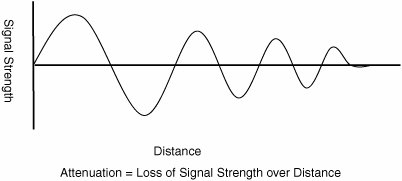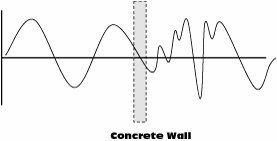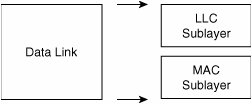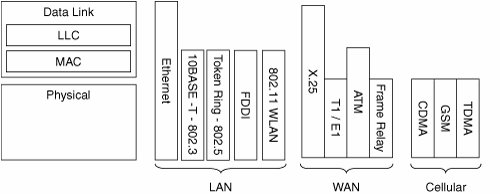OSI Layers and WLANs
| Let us start with the idea that complex problems are usually broken down into modular components to facilitate understanding and to make the solution more tractable. For this purpose, data communications make use of the Open Systems Interconnection (OSI) reference model. Given the extensive coverage of this model available in other books, this book does not intend to provide a complete and exhaustive overview of the OSI reference model. Instead, this section provides a brief summary of the model and focuses on the sections that are most relevant within the context of this book. Note The OSI model was defined by the International Organization for Standardization (ISO) and was conceived to allow interoperability across the various platforms offered by vendors. A provisional version of the model was first published in March 1978 and became standardized in 1979 after some minor refinements. The OSI model breaks the overall task of communication into layers that focus on relatively delimited and well-defined subtasks. Within this framework, two types of communication occur:
The seven layers that make up the OSI reference model and the two communication types are illustrated in Figure 1-1. Figure 1-1. OSI Reference Model Note The number seven has no specific meaning or purpose. The ISO defined the OSI reference model and subsequently tasked subcommittees to work out the details for each layer. The following sections provide more detail on each of the respective OSI layers. Layer 1: Physical LayerThe purpose of the physical layer is to perform the actual transmission of information across a link. As such, it covers characteristics that are related to the physical properties and distinctiveness of the network. This includes the transport medium, topology, data encoding techniques, transmission speeds, maximum transmission distances, voltage levels, connectors, pin functions, conversion of information into signals, and synchronization. The physical characteristics that are most important in the context of this book are the transport medium, the topology, and the data encoding techniques. An overview of each follows. Transport MediumThe transport medium defines the type and characteristics of the physical channel that carries information. In its strictest sense, the channel is used as a tunnel for electricity or electromagnetic waves. For the purpose of this book, this section makes the distinction between electrical, optical, and radio channels. An electrical channel makes use of copper wires to conduct electrons or electricity from source to destination. An optical channel employs a fiber optic cable to guide light between the emitter and the receiver. Finally, a radio frequency (RF) channel utilizes the radio band of the electromagnetic spectrum to carry signals. A key difference of RF is that the RF channel is not bounded or confined to the actual physical systems but relies on the free space of air. Indeed, RF is truly unbounded because the ether has no borders. Because RF signals are not guided by a conduit, they can theoretically propagate in any direction. This borderless characteristic of RF has two important implications:
The broadcast nature of radio communication has important implications for both WLAN technology and applications. For example, transmissions can inherently be intercepted by any network-attached station. When combined with nondirectional antennas, every station intercepts every transmission of every other station. Not only does this have security implications, but it also requires methods for resolving orderly access to the air. These implications will be covered in greater detail in Chapter 7, "Security and Wireless LANs." TopologyThe following list describes the four basic topologies for networks consisting of three or more nodes:
Figure 1-2 illustrates the different topologies. Figure 1-2. Network Topologies By construction, WLANs adopt a bus topology because they use radio as their transmission channel. The radio spectrum forms the bus, and every node always hears every transmission from every other node. This is only true for a bus topology. Confusion might arise due to the physical layout of WLANs. The access point (AP), which acts as a bridge, forwards all data it receives. The impression arises that WLANs adopt a star topology. However, star topologies provide singular and dedicated connectivity between the stations and the central hub, which is not the case for WLANs. In WLANs, the transport medium is shared among all connected stations. Hence, a distinction must be made between the physical appearance of a star topology and the logical layout and behavior as a bus topology. Data EncodingData encoding is the transformation of information into a form that is suitable for the transmission medium. Adverse transmission effects such as attenuation, distortion, and interference are taken into consideration when selecting an encoding method for a particular physical channel. Attenuation is the loss of signal strength. This can be due to impurities of the transmission medium. Copper has a natural resistance at room temperature. Similarly, fiber optic cables contain impurities that reduce signal strength with distance. With regard to radio signals, one cause of loss of signal power is materials that the signal encounters. The encountered materials cause absorption or reflection resulting in a reduction of signal strength (see Figure 1-3). For example, water absorption bands are 22, 183, and 323 GHz, and the oxygen absorption regions are 60 and 118 GHz. Figure 1-3. Attenuation of a Radio Signal Another cause of attenuation of radio signals is the increasing volumetric spread of the signal as the distance from the source increases. Incoherent electromagnetic wavesas opposed to coherent electromagnetic waves such as laserslose signal focus in function of the distance traveled. The loss of focus corresponds with a loss in power as the power is distributed over a greater area. This effect can clearly be seen in flashlights. With constant power levels of the source, the beam's footprint increases and the intensity of the light decreases the farther you are away from the source. Distortion is the process of the physical medium influencing frequency components of the original signal in different ways. The amount of resistance that a physical entity has on a signal medium is partly determined by the frequency of the signal that passes through it. Different materials affect the RF signal at different levels. The effect of lead versus glass on a low-frequency signal will be different from a high-frequency signal. The result is an undesirable change in the shape of the radio wave or distortion of the signal that increases with transmission distance (see Figure 1-4). Figure 1-4. Distortion of an RF Signal As It Passes Through Concrete Note Common definitions of the frequency band groups are low, high, and ultra-high. Low bands range from 0 to 30 MHz, high bands from 100 to 300 MHz, and ultra-high bands from 300 MHz to 3 GHz. Interference occurs as a result of outside influences. In copper, inductive currents created by external electromagnetic fields mutate the original signal's character. Sometimes referred to as noise, in RF, interference is actually the disturbance of one radio signal by another of the same frequency. The various transposed signals either boost or reduce frequency components of the original signal, leading to modification of the original signal's profile. Figure 1-5 shows both the single undisturbed RF wave and the RF wave when another is introduced. The second diagram shows that when the other wave is added, it "interferes" with the original wave. Figure 1-5. Interference of an RF Wave by a Second Signal Data encoding techniques are used to construct a robust, reconstructable signal for the given medium. The techniques not only define how digital information is encoded into and decoded from respective electrical, optical, or radio signals, but also provide methods for error detection and correction. Layer 2: Data Link LayerThe role of the data link layer is to provide reliable transit of data across a physical link. Specifications define physical addressing, sequencing of frames, flow control, and error notification. Error notification alerts upper-layer protocols that a transmission error has occurred. Sequencing of data frames reorders frames that are received out of sequence. Finally, flow control moderates the transmission of data so that the receiving device is not overwhelmed with more traffic than it can handle at any given time. IEEE has subdivided the data link layer into two sublayers:
Figure 1-6 illustrates the IEEE sublayers of the data link layer. Figure 1-6. OSI Data Link Sublayers The LLC sublayer manages communications between devices over a single link of a network. LLC is defined in the IEEE 802.2 specification and supports both connectionless and connection-oriented services used by higher-layer protocols. IEEE 802.2 defines a number of fields in data link layer frames that enable multiple higher-layer protocols to share a single physical data link. The MAC sublayer defines the contention resolution method for access to the physical medium. In addition, the MAC specification defines MAC addresses that, at the data link layer, uniquely identify devices. The combination of Layer 1 and MAC specifications define the type of LAN network. WAN standards are typically defined solely by their Layer 1 characteristics. The same is true for cellular communications standards. For example, a T1/E1 network is defined by its underlying Layer 1 (physical) network. Figure 1-7 illustrates the OSI positioning of various common networking standards. Figure 1-7. OSI Technology Reference Chart Given the lesser importance of Layers 3 to 7 in the context of this book, a brief overview is provided for the remaining OSI layers. Consult other books, such as the following, if you would like in-depth coverage of these respective layers:
Layer 3: Network LayerLayer 3 supports network addressing, route selection, congestion control, and packet fragmentation and reassembly. IP is today's most commonly employed network layer protocol. Layer 4: Transport LayerThe transport layer manages end-to-end connections over both connection-oriented and connectionless links. In addition, its specification includes sequencing, flow control, and the capability for error-free delivery. The Transport Control Protocol (TCP) is an example of a Layer 4 protocol used on the Internet. Layer 5: Session LayerThe session layer establishes, manages, and terminates communication sessions. Communication sessions consist of service requests and service responses that occur between applications located in different network devices. This layer is typically not encountered in today's Internet environment. However, protocols such as AppleTalk include session layer implementations. Layer 6: Presentation LayerThe presentation layer ensures that information sent from one system is readable by the receiving system. It employs coding and conversion schemes to provide common data representation formats and conversion of character representation formats because systems may adopt different ways of representing data. Examples of common data representation formats are ASCII and Extended Binary-Coded Decimal Interchange Code (EBCDIC). Finally, the presentation layer supplies common data compression (MPEG, JPEG, GIF, TIFF) and common encryption schemes that enable data encrypted at the source device to be properly deciphered at the destination. Layer 7: Application LayerThe application layer interacts with software applications that require a communications component. As such, its functions include defining syntax, identifying communication partners, determining resource availability, and synchronizing communication. Some commonly used programs fall outside the scope of the OSI model. For example, Microsoft Internet Explorer does not fall within the OSI framework. The HTTP agent embedded in Explorer, however, does form part of the OSI application layer. |
EAN: 2147483647
Pages: 163
